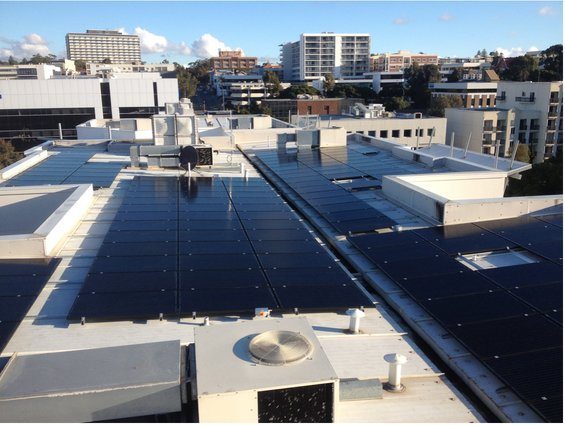
Peter Breen talks with Rob Isaacs about the solar panel installation for the Market Rise apartments in West Perth, a four-tower 8-storey strata site. Rob is the part-time building manager for this 94 lot residential complex.

which includes 40kW of Daqo panels on the Central Tower
Peter: What were the reasons for deciding to install solar panels?
Rob: Well, obviously, reducing energy bills and reducing our carbon footprint was the primary reason, but we also wanted to demonstrate to the high-rise residential market in the West Perth CBD that it is possible to retrofit high-rise solar panels. In 2014, the cost of mains power for the common property for this complex was in excess of $35,000 per year even after making some changes in lighting to LED. Having identified large areas on the roofs of the four-tower 8-storey complex, the idea to become largely self-sufficient during the day was put forward.
Peter: What was the starting point?
Rob: As an apartment owner in the complex and with solar energy being very topical, my partner suggested that we look into providing solar power for the building’s common property. An advertisement on social media made me think about the big drop in the cost of solar panels, so I went to the market to see what it had to offer, without knowing anything about the players and the technologies involved.
Peter: How did you find a solution?
Rob: For such a relatively large installation, and on the top of four 8-storey buildings, there was some interest from small players, but as a strata company run by volunteers, we had to find an installer that would include system monitoring in the package. We simply couldn’t rely on our Strata Manager to do this as they don’t have the expertise, nor are they set up to do so. So, I ended up in discussions with two large installers, one of which recommended a central inverter system and the other a micro-inverter system.
Peter: So, which technical solution did you adopt?
Rob: I spoke with some independent people on the benefits and deficiencies of both technologies. At the end of the day, it came down to cost and component reliability, and because we had a large area to play with which had little shadowing, we decided to go for the central inverter system.
Peter: Tell me a little bit about the system then.
Rob: We ended up using two SMA 15kW inverters to give us the maximum 30kW output. In WA, once you go above 30kW, the approval time from the power authority and the cost of that approval apparently goes up quite significantly. So, most systems involving private residential developments stop at 30kW. Coupled to the inverters and to maximise space on the roof for maintenance of various other plant and equipment, we used 140 high output Daqo panels.
Peter: How’s the system performing?
Rob: Since commissioning at the beginning of July 2015, production has been pretty much in line with expectations, even allowing for the overcast conditions we’ve had in Perth this year. The amount of solar radiation has been about 5% down on the long-term average. Despite this, we’re producing more power than we can use during the day, using around 3,000kWh per month and sending about 750kWh back to the grid. We’ve had our pool under renovation during this period too and when that comes back on line, we’ll use all the electricity we’re producing. Come October, I expect we’ll be close to maximum production of around 7,000kWh per month for the following 6 months.
Peter: In summary what does all this mean?
Rob: It means that our energy bill will be reduced from $35,000 per year to around $20,000 with a forecast reduction of carbon of 50 tonnes per year. All up, the system cost about $60,000 to install which means we will recover our capital outlay in four years. And, with the amount of energy being sent back to the grid, my aim is to come up with a business case to introduce battery storage for what we can’t use in the middle of the day. We’re on a peak/off-peak tariff and there’s an obvious need to bring down grid consumption in the latter hours of the day.
This article is posted by Peter Breen http://www.renewableenergy.org.au/ You can contact Rob Isaacs at rob@accessdesign.com.au
